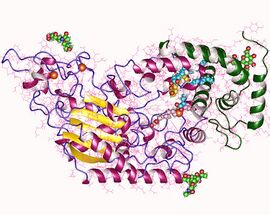Acyloxyacyl hydrolase
Topic: Biology
 From HandWiki - Reading time: 3 min
From HandWiki - Reading time: 3 min
| acyloxyacyl hydrolase | |||||||||
|---|---|---|---|---|---|---|---|---|---|
 Acyloxyacyl hydrolase heterodimer, Human | |||||||||
| Identifiers | |||||||||
| EC number | 3.1.1.77 | ||||||||
| Databases | |||||||||
| IntEnz | IntEnz view | ||||||||
| BRENDA | BRENDA entry | ||||||||
| ExPASy | NiceZyme view | ||||||||
| KEGG | KEGG entry | ||||||||
| MetaCyc | metabolic pathway | ||||||||
| PRIAM | profile | ||||||||
| PDB structures | RCSB PDB PDBe PDBsum | ||||||||
| Gene Ontology | AmiGO / QuickGO | ||||||||
| |||||||||
The enzyme acyloxyacyl hydrolase (EC 3.1.1.77, AOAH) was discovered because it catalyzes the reaction
- 3-(acyloxy)acyl group of bacterial toxin + H2O = 3-hydroxyacyl group of bacterial toxin + a fatty acid
The enzyme removes from lipid A the secondary acyl chains that are needed for lipopolysaccharides to be recognized by the MD-2--TLR4 receptor on animal cells. This reaction inactivates the lipopolysaccharide (endotoxin); the tetraacyl lipid A product can inhibit LPS signaling. Acyloxyacyl hydrolase is produced by monocyte-macrophages, neutrophils, dendritic cells, NK cells, ILC1 cells, and renal cortical tubule cells. It is a protein of about 60 kDa that has two disulfide-linked subunits. The smaller subunit, of about 14 kDa (including glycosylation), is a member of the SAPLIP (saposin-like protein) family along with amoebapore, granulysin, acid sphingomyelinase, surfactant protein B, and the 4 sphingolipid activator proteins (saposins). The larger subunit, of 50 kDa, contains the active site serine and the other elements of the His-Asp-Ser triad; AOAH is a GDSL lipase that has activity toward certain glycerolipids in addition to its presumed major in vivo substrate, LPS. Also see "AOAH".
References
- "Deacylation of structurally diverse lipopolysaccharides by human acyloxyacyl hydrolase". J. Biol. Chem. 265 (27): 16444–9. 1990. PMID 2398058.
- Hagen, F.; O'Hara PJ, Munford RS; characterization of recombinant human acyloxyacyl hydrolase, a leukocyte enzyme that deacylates bacterial lipopolysaccharides (1991). "Expression". Biochemistry 30 (34): 8415–8423. doi:10.1021/bi00098a020. PMID 1883828.
- "Acyloxyacyl hydrolase, a leukocyte enzyme that deacylates bacterial lipopolysaccharides, has phospholipase, lysophospholipase, diacylglycerollipase, and acyltransferase activities in vitro". J. Biol. Chem. 267 (14): 10116–21. 1992. PMID 1577781.
- "GDSL family of serine esterases/lipases". Prog. Lipid Res. 43: 534–552. 2004. doi:10.1016/j.plipres.2004.09.002. PMID 15522763.
- "Biochemical transformation of bacterial lipopolysaccharides by acyloxyacyl hydrolase reduces host injury and promotes recovery". J Biol Chem 295 (51): 17842-1785. 2020. doi:10.1074/jbc.REV120.015254. PMID 33454018.
 |
 KSF
KSF